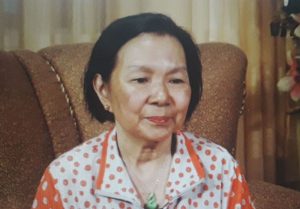MANILA — Senior citizen Hilda Pua was diagnosed with stage 4 lung cancer when she was 56 years old. The diagnosis surprised her because she never smoked a single cigarette all her life. Later on, her surprise turned to fear as thoughts of bedridden cancer patients crossed her mind.
“Natakot ako kasi cancer, natakot din ang mga kapamilya ko kasi akala nila hindi na ako gagaling (I was scared because it’s cancer, my family members got scared, too, because they thought I won’t survive the disease),” she said in an interview.
Pua explained that she was first treated as a simple lung infection patient by other doctors before medical oncologist Denky Shoji dela Rosa told her that she has cancer as per biopsy results.
Dela Rosa told the Philippine News Agency (PNA) that Pua is just one of the many non-smokers who contracted the disease at its late stages.
“Smoking and lung cancer are highly-correlated. But smoking is not the only cause of it because even those who don’t have history of smoking can have it. Like in my practice, the number is quite significant, it can range from 15 to 30 percent of my patients,” she said.

Since many Filipinos are unaware of this fact, dela Rosa said even doctors have the tendency to dismiss possible lung cancer patients.
“We have a lot of tuberculosis cases here in the Philippines, so some doctors just label a nagging cough as a symptom of it, instead of looking into the possibility of lung cancer, even if they see a mass during an X-ray,” she added.
The late senator, Miriam Defensor Santiago, is one of the non-smoker personalities worldwide who died of lung cancer.
In an earlier interview with newsmen, Santiago disclosed that she was diagnosed with stage 4 lung cancer caused by genetic mutation. She had been treated through modern chemotherapy, which has been reduced to a tablet called molecular targeting.
“One more example is Dana Reeves, wife of ‘Superman’ Christopher Reeves. She’s a non-smoker, died at 45, because of lung cancer, barely two years after Christopher died,” dela Rosa said.
According to the latest World Health Organization (WHO) data, lung cancer deaths in the country reached 11,365 or 1.84 percent of total deaths. The age-adjusted death rate is 16.99 percent per 100,000 of the population and it ranks Philippines number 72 in the world.
WHO reported that genetic mutation and indoor pollution are two of the main causes of lung cancer among non-smokers.
Genetic mutation is a situation where lung cancer can be “inherited or acquired during your lifetime.” On the other hand, indoor pollution happens in households, where families cook using solid fuels like wood and coal or cook over open flames.
WHO also reported that around 3 billion people who come from low-income families are at risk of lung cancer due to indoor pollution, especially in rural China and third-world countries.
Dela Rosa said there are several ways, by which lung cancer can be treated—surgery, chemotherapy, radiation therapy, targeted drug therapy, and palliative care.
“The good news is we are now equipped with the ability to test the tumor precisely to determine the treatment that will give the patient the best response and the survival without the traditional side effects of chemotherapy,” she said.
The first three are the most common types of cancer treatments compared with targeted drug therapy.
Targeted drug therapy, also known as molecular profiling or mutation testing, often works two ways. It blocks growth signals in the cells so the tumor stops getting bigger, or it blocks new blood supplies that may nourish the growth of cancerous cells.
Meanwhile, palliative treatment helps to ease the pain cancer patients feel and lessen some of their symptoms, whether they’re treated or not.
Dela Rosa stressed that early diagnosis of the disease is important for its successful treatment, but most patients are diagnosed with lung cancer at the advanced stages.

“Like with Mrs. Pua she had a tumor about 8 to 10 centimeters, which have already been there probably for 5 to 10 years and she only developed the symptoms like back pain, when it transferred to her spine. It (the tumor) can actually transfer to the liver, the bones, and the brain,” she said.
Dela Rosa advised the public to consult a doctor in the event of persistent symptoms like coughing and back pain.
“When your symptoms are persistent and your chest x-ray is clear, you really have to prod your doctor because I think most patients who have something serious, they know it at the back of their minds and sometimes when the patients don’t really look very sick, doctors shrug off the symptoms, personally, I do credit patients’ intuition,” she said.
Once treated, dela Rosa said it is important for lung cancer patients to have a balanced diet, exercise, and lead a healthy lifestyle so they can live quality lives.
Pua said her condition improved when she underwent treatment and took her medicines consistently in the past six years.
“Sa mga may lung cancer gaya ko, huwag tayo matakot kasi may mga bago nang gamot ngayon, nung gumaling ako, okay pala, asa lang tayo sa Diyos, kumain lang ng healthy foods saka relax lang (To those who have lung cancer like me, let’s not be scared because there are new medicines today, it was okay when I got well, let’s depend on God, eat healthy food, and just relax,” she added. –PNA
